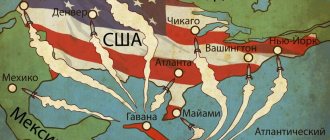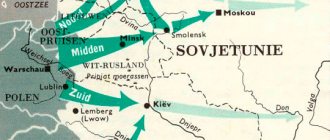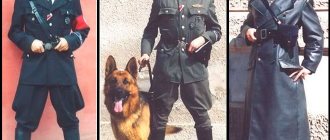Brief history of creation
The end of World War II led to the creation of a bipolar world: two powers (the USA and the USSR) had the greatest economic and military influence in the world. After the disappearance of the fascist states, whose existence had a unifying character for other countries, new political blocs and alliances began to form. The following factors contributed to the creation of the Warsaw Pact organization:
- the desire for dominance in world politics on the part of leading powers, as well as countries that were part of friendly alliances;
- dramatic shifts in the balance of power after the war, as a result of which each of the leading powers tried to acquire useful allies in a particular region;
- preventing a new global war, especially given the emergence of nuclear weapons in the arsenals of countries, as well as the increase in local conflicts in different parts of the world.
On May 11-14, 1955, a meeting of European states was held to ensure peace and security in Europe. The result was the creation of the Warsaw Pact Organization (WTO), which included 8 socialist countries:
- Albania (stopped participating in the organization in 1961 for ideological reasons, formally withdrew from the treaty after the entry of troops into Czechoslovakia in 1968);
- Bulgaria;
- Hungary;
- German Democratic Republic;
- Poland;
- Romania;
- THE USSR;
- Czechoslovakia.
For comparison, the NATO bloc in 1949 included 12 countries.
The Minister of Defense of the People's Republic of China was present at the Department of Internal Affairs as an observer. The agreement between the countries was signed for 20 years with an automatic extension of validity for 10 years in the absence of applications for termination. In 1985 it was extended for 20 years. In 1990, the Socialist Party of Germany left the union, and a year later, in 1991, the military-political alliance collapsed due to the displacement of communist regimes.
The flag, emblem and symbols of the Department of Internal Affairs consisted of a handshake depicted against the background of a shield, a circle and a red star. At the base there was a ribbon with images of allied countries. On the circle there was a laconic inscription: “Union of Peace and Socialism.”
1966-1980
During this period, the military doctrine of the Department of Internal Affairs provided for the gradual development of actions. It was supposed to start with the use of only conventional weapons, limited use of nuclear weapons, gradually moving, if necessary, to their massive introduction. Nuclear weapons could only be used if they were used by NATO. As before, special attention was focused on carrying out a strategic offensive on enemy territory in order to quickly defeat his main forces and capture the most important economic regions. This doctrine was similar to the American "flexible response" program.
Governing bodies
The highest collective body of this organization was the Political Consultative Committee (PAC). Its purpose is to carry out consultations, as well as consider issues related to the implementation of the Warsaw Pact. All 8 participating countries were represented on the committee. As a rule, the meetings were attended by general secretaries of communist parties, heads of government, and other officials.
The agenda included discussion of acute foreign policy problems and international issues that related to the defense capability and security of participants in the internal affairs division. Reactions to certain world events were collectively developed and agreed upon. Such meetings did not have a clear meeting schedule and were held as needed. The main bodies were the Committee of Foreign Ministers, the joint Secretariat and the Committee of Defense Ministers.
There was also a body for the leadership of the army and military contingent - the Joint Command of the Armed Forces. In addition to joint command of troops, the military council discussed the problems of improving the operational and combat training of the army. It included generals, admirals and officers of all members of the union. The OKVS headquarters was located in Moscow, commanders-in-chief were appointed by mutual agreement.
In addition, there was also a general headquarters of the organization in Moscow. The purpose of the headquarters was to coordinate the work and control over the implementation and compliance with the ATS charter.
Early 80s strategy
It is based on the principle of readiness to fight any kind of battle. In accordance with this doctrine, military operations were assumed both without nuclear weapons and with them. At the same time, a number of local battles using conventional weapons were envisaged. Preemptive nuclear strikes were not planned. At the same time, nuclear weapons were allowed to be used only if they were used by the enemy. Along with strategic offensives on enemy territories, large-scale defensive operations were also planned.
Union activities and declarations
During the entire existence of the Department of Internal Affairs, 4 declarations were adopted . Their goal was to conclude a non-aggression pact between the Warsaw Pact countries and the NATO bloc, unilaterally renounce nuclear testing (provided that Western countries also renounce such research for military purposes) and create protective measures against the nuclear forces of the North Atlantic Alliance. Sometimes the historical tables also mention the Budapest Declaration, which calls on European countries to look for ways and means of cooperation.
In addition, joint military exercises and maneuvers were conducted. From 1963 to 1988, there were more than 30 of them. All operations received code names and were carried out on the territories of the participating countries. Coordination activities between countries were also carried out in the field of intelligence: since 1979, a classified system for intercepting information for conducting global electronic reconnaissance began to operate.
Important events also include cases of military intervention by the USSR in allied countries . The first incident occurred in 1956 in Hungary, where a rebellion broke out against the Soviet regime. After the entry of Soviet troops, the uprising was suppressed with a large number of casualties, and this incident became one of the key ones in the Cold War, since it was clear that the USSR was ready to use military power to maintain its positions in friendly countries. Some sources claim that the Hungarian uprising was actively sponsored and supported by certain Western countries, including the United States.
The second case was the entry of Soviet troops into Czechoslovakia (Operation Danube). The course towards policy change, liberalization and alienation from socialist countries led to popular rallies and discontent. After unsuccessful negotiations with First Secretary Alexander Dubcek, about three hundred thousand soldiers of the Soviet army were brought into the country, which caused the emigration of many people. This operation became the reason for Albania's withdrawal from the Department of Internal Affairs. It did not find support in the USSR either - on August 25, 1968, one of the most significant demonstrations of dissidents took place on Red Square.
Conditions
The agreement included a preamble and eleven articles. According to the terms of the document, as well as the UN Charter, the Warsaw Pact countries assumed obligations to refrain from the use of force or the threat of its use in international relations with other states. If an armed attack is carried out on any of the parties to the Agreement, the others must immediately provide assistance with all means at their disposal, including army forces.
Disintegration of the organization
In 1990, the organization no longer included 8, but 6 countries. On September 24, 1990, as a result of the unification of East and West Germany, the Minister of Defense of the GDR, Eppelmann, signed a protocol on the withdrawal of the GDR from the Department of Internal Affairs. However, at that time the USSR was in such a crisis that it was clear: the Warsaw Pact was living out its last days. The essence of the crisis was as follows :
- development of the military industry to the detriment of other industries;
- economic crisis;
- uncontrollable rise in inflation;
- stagnation in politics, lack of competition in the ranks of the CPSU (there was only the appearance of the people's will);
- a sharp change in the direction of economic and political development as a result of Gorbachev’s reforms.
On February 25, 1991, the allied countries decided to eliminate the joint military forces. Already on July 1 of the same year, taking into account the changes taking place in Europe and on the world map as a whole, a protocol on the termination of the document was signed, which automatically meant the dissolution of the Warsaw Pact Organization. On the USSR side, it was signed by Vice President Gennady Ivanovich Yanaev. An interesting fact is that all member states of the Warsaw Warsaw Forces are now members of the NATO bloc (including some countries of the former Soviet Union).
List of alliance member countries
Which countries are members of NATO at the present stage of the organization’s existence can be seen on its official Internet resource. The current list of NATO member countries includes 29 countries at the end of 2017. Among them are the 12 founding countries of the alliance:
- France.
- Belgium.
- USA.
- Canada.
- Netherlands.
- Great Britain.
- Norway.
- Iceland.
- Denmark.
- Luxembourg.
- Portugal.
- Italy.
In the second half of the 20th century, several more countries joined the North Atlantic Alliance.
- Türkiye.
- Greece.
- Germany (1952 Germany).
- Spain.
- Poland.
- Hungary.
- Czech Republic.
The most significant and massive expansion of the alliance occurred at the beginning of the 21st century, when it included the countries of Eastern Europe and the Baltic states.
- Lithuania.
- Latvia.
- Estonia.
- Slovenia.
- Slovakia.
- Romania.
- Bulgaria.
- Albania.
- Croatia.
- Montenegro.
The list of NATO members will certainly grow over time. This is due to the desire of many states to participate in the work of this bloc and be protected by its powerful military potential.
Exercises "Brotherhood in Arms"
This was a combined arms event that took place on the territory of the GDR and the Baltic waters adjacent to it. The exercises were conducted according to the plans of the Joint Command. The head of the operations was General Hoffmann of the German Army. During the exercises, the 234th Guards Parachute Regiment of the Red Banner Chernigov Division was deployed. Everyone present at the observation deck was delighted with the soldiers’ training. All personnel received gratitude from the USSR Minister of Defense and an award - the Pennant for military valor and courage. It is worth saying that this was the first in the history of the Airborne Forces to drop 1,200 people from a height of four hundred meters in difficult weather conditions. Marines of the Baltic Fleet also took part in the events. From the national army of the GDR, the 40th parachute battalion showed its skills. The exercises ended on September 12, 1980 with a parade in Magdeburg. Unlike previous events, Operation Brotherhood in Arms was distinguished by a wider range of operational training tasks, a larger number of personnel, and a territorial scope. These exercises became a serious test for the United Army. The conclusions that were obtained during the maneuvers on issues of operational art and tactics had a significant impact on subsequent training of the Armed Forces.
The meaning of Poland
In mid-October 1955, a Protocol of Agreements between the Soviet and Polish governments was signed in Moscow. In accordance with it, the Polish Armed Forces, in addition to the air defense forces, had to send part of their operational troops, consolidated into the Primorsky Front from the air and three combined arms armies. These forces were to operate in the United Armed Forces of the allied states in the second strategic echelon in the auxiliary direction. Their task was to cover the right flank of the main strike force of the USSR, as well as the sea coast from possible landings of NATO troops.
OBC
The armed forces of the Internal Affairs Directorate included assets from the armed forces of the allied states. The size of the armies was agreed upon by bilateral agreements between the Soviet government and the leadership of other countries. Documents were updated every 5 years. This was due to the development of programs for the development of the armed forces of individual states in the next five-year plans. During the peace period, only the most trained forces were present in the United Forces. In case of war, they were joined by operational units that were trained to fight on external fronts.
"Shield-79"
Operational-tactical maneuvers under this code name took place from May 12 to May 19, 1979. Troops and headquarters of the Hungarian, Bulgarian, Czechoslovak, Soviet armies, as well as the Romanian Armed Forces, took part in the exercises. The head of operations was the Hungarian general Tsinege. During the exercises, issues on the conduct of combat operations by the combined efforts of the allied armies were worked out. The events demonstrated the increased level of operational and tactical training of officers, generals and staffs. The exercises contributed to the subsequent interaction of the armed forces of the allied states, as well as the strengthening of combat cooperation between them. Mainly ground forces, together with air force units and units, were involved in the events.









